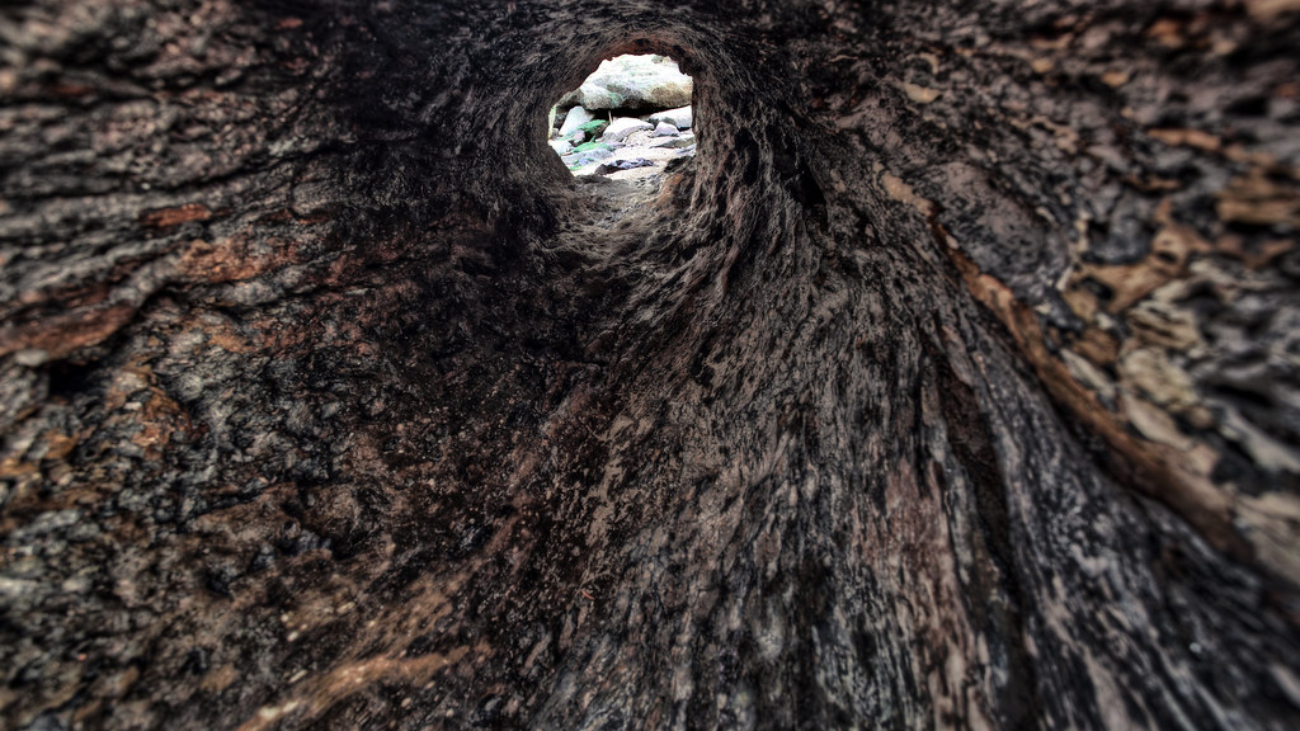Until we have properly cultivated love, the extremes of Thelemic magical and mystical experience remain off-limits.
The Gnostic Mass and Thelemic Ethics
A religious rite ought to form a religious community around a common ethos: a set of commonly held values that are both cause and effect of the commonly recognized highest power.
The Thelemic Background of the Gnostic Mass
The Book of the Law is the key to understanding the theology of the Gnostic Mass and its Creed.
The importance of humility
I try to instill this attitude now in people who are new to Thelema: Don’t assume you know anything let alone everything!
The Sphinx and the Gnostic Mass
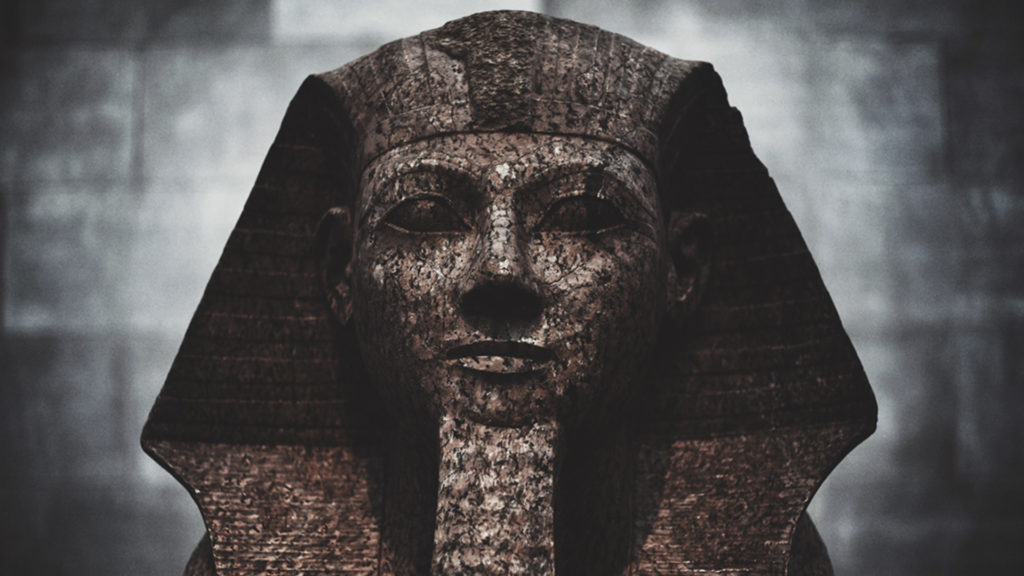
Part VIII of the Gnostic Mass—Of the Mystic Marriage and Consummation of the Elements—could be viewed as the formation of the Sphinx out of the Priest and Priestess (or the elements attributed to them, if you prefer).
The Sphinx represents the elements balanced in the individual. It is a hieroglyph of the individual who has made themselves an image in matter of the divine. The divine is the Phallus, the Pyramid, or the Sun, who the balanced individual is now the “bride” of.
Crowley specifically refers the Lion and the Dragon to the Beast and the Man and the Bull to Babalon. I take this to mean that the Sphinx is the balanced woman (Libra) or the Master of the Temple. This is another reason for Crowley’s cryptic remark at the end of Liber XV that the officers of the Gnostic Mass are all “parts of the Priest.”
Alternatively, man and woman coming together, at least under certain circumstances, could be seen as creating a third, divine entity.
It also offers another way to think about the “sacrifice of life and joy”. What’s being sacrificed is the unbalanced aspects of the elements. They are being united into a coherent whole, directed by the Will of the magician, and offered up to the Bridegroom, the Sun, for erotic destruction.
The Unity of the Three Lords
As I showed yesterday, there are three Lords mentioned in Liber XV: the one secret and ineffable Lord of the Creed (aka the Lord secret and most holy of the 2nd Collect), the Sun (the one Star in the Company of Stars of the Creed aka the Lord visible and sensible of the 1st Collect), and CHAOS (the sole viceregent of the Sun upon the Earth of the Creed and the Lord of Life and Joy who we adore in the 5th Collect). But these aren’t three completely separate individuals. They’re actually one Lord with three aspects or faces.
I am Heaven, and there is no other God than me, and my lord Hadit.
Liber AL vel Legis, I.21
The first Lord—the one secret and ineffable Lord mentioned in the Creed and the 2nd Collect—is Hadit. Hadit is the point of view or subjectivity of each individual. It is Hadit’s union with Nuit—space and matter—which gives rise to the manifest universe, the observable universe, the experiential universe, etc. This is covered in Crowley’s Introduction to the Book of the Law.
In any experience you may have, Hadit is always that to which the experienced event occurs, never the thing experienced itself. From this, two truths immediately follow. (1) Hadit has no nature of his own (since nature is always something experienced (see Djeridensis Comment on AL II.2)); and (2) one cannot even experience let alone worship Hadit. (See New Comment to AL II.8.)
From this we may infer that (3) the first 14 lines of the Anthem are directed at Hadit (ill, presumably, because Hadit is the one delivering the lines).
From the Anthem we also learn that Hadit is the “centre and secret of the Sun”. The Sun is the second Lord (the one star of the Creed and the Lord visible and sensible of the first Collect). We also learn from the Priest’s veil speech that the Sun is “our Lord in the Universe,” i.e., the macrocosmic deity. In the context of the Mass, the Sun represents both what people have in mind when they casually think of God (i.e., the Lord of the Universe) and also the literal Sun which impacts the Earth with electromagnetic energy.
What we’re being told in the Mass is that the essence of the Sun—basically the essence of God—is identical with the essence of ourselves. That elusive subjective viewpoint within yourself which you can never quite grasp or get to the bottom of—which always manages to slip away when you turn to look at it—is actually the essence of divinity.
Now the Sun also serves other purposes in the Mass. It is also a principle of unification, a principle of sacrifice, and a principle of resurrection. But all of these are tied together in the single magical act toward which the Mass aims. That magical act is apparently one of self-sacrifice. The Priest offers his life/body and joy/blood to the Sun. What he is in essence proclaiming, performing, and realizing is that these things are not Hadit. They belong to Nuit. By giving up all that he is, was, or could be to the Lord of the Universe, he is in a certain sense annihilating himself. But at the same time, he is becoming Hadit. (See AL II.6.) He is undergoing spiritual death (within this incarnation) in order to realize who he truly is. So his act of self-sacrifice is a unification (seeing everything as part of one unified whole in Nuit) which is also a spiritual resurrection (thus fulfilling the formula of IAO, which is just another name of the Sun).
This is complex, but if you grasp this, you grasp Thelema.
Now how does our third Lord, Chaos, come in to this?
The simplest way to understand this in the context of the Mass is that Chaos is the drive within each of us toward union with Nuit. It is the Hadit within us but manifested as a drive toward completion, wholeness, and annihilation through self-sacrifice.
Chaos is the drive toward erotic liberation. It’s the unity of sex and death.
This is why when the Priest offers up his body/life and blood/joy to the Sun, he says, “Let this offering be borne upon the waves of Æthyr to our Lord and Father the Sun that travelleth over the Heavens in his name ON.”
ON is ענ. Ayin and Nun are two of the paths going up the Tree of Life into Tiphareth, the House of the Sun. Ayin is the Devil, the goat, the phallus, the perfected will. It’s life and joy on Earth, in this incarnation. Nun is Death. Both paths terminate in the Sun, the principle of unification and resurrection. Ayin (70) plus Nun (50) is 120, a number associated with resurrection in the Golden Dawn Adeptus Minor ritual. But let’s translate this out of occult-ese into something real.
What we think of as God (call it the Sun or Jehovah or Allah or whatever you want) is really something within each of us which we in some sense project on to reality or on to a transcendent author of the universe. If God in the exoteric sense really exists, His essence is Hadit, the same as our own essence, which is our subjective point of view. So God is really within us.
The reason we don’t realize we are God is because we are confused about ourselves. We identify with our bodies, our minds, our emotions, our thoughts, our plans, our wishes, our desires, our personalities, our tendencies, etc. All these things we think are us, are ours, are I/me/mine are nothing of the sort. They are actually all Nuit. (Technically, they’re the Khu.) One of the most important ways in which we can realize our own divinity is by giving all those things back to her: by sacrificing all that we think we are to Nuit. (See AL I.65 and also The Wake World.)
This sounds like we’re creating a duality or an opposition between self and other. It sounds like we’re rejecting all these things we think of as self. But that’s only apparent. Just stop and think about it for second. What does it take for you to give your body back to Nuit? Isn’t your body already in space? Aren’t your thoughts already occurring in an awareness which is space-like? Can you possibly notice your body without also noticing space? Can you possibly notice your thoughts and feelings without also noticing awareness?
Now look at it from the other side. Hadit doesn’t have any nature or any being, so there is nothing to oppose to Nuit. Hadit is just (unreflective, “foolish”) going. In an experience of something seen, there is the thing seen (Nuit), and there is the act of seeing (Hadit). In an experience of something thought, there is the thing thought (Nuit), and there is the thinking (Hadit). The confusion comes with thinking that the thing seen or thought is us. We confuse ourselves with our thoughts.
There’s a Zen saying to the effect of, “In the seeing only the seen, in the hearing only the heard,” etc. That’s very apropos here.
The idea of erotic liberation is that, deep down, the Hadit in us wants nothing more than union with Nuit. It doesn’t want union with this or that part of her. It wants union with her, with everything. It doesn’t care about the particulars. Anything that arises for it is as good as anything else. (AL I.22) It wants to fuck the universe.
That innate drive to fuck the universe manifests itself as the sex principle in a religious or spiritual context. It’s the original nature worship. Those who realize this belong to the “true church of old time”. They understand that apotheosis or liberation depends upon self-transcendence. It requires self-abandonment. It requires an act of love so powerful, an ecstacy so intense, that it completely and permanently obliterates the sense of separateness from life and joy.
The Saints are those who “got it”. They destroyed themselves through erotic destruction and as a result got to really, truly live.
Let’s hit it from another angle: the phallus (Chaos) is the natural being or natural will perfected. By “natural will” I just mean your desire: what you want.
Thelemites are fond of saying “I will this” and “I will that”. That might be your natural will, but it’s not your true will. It can’t be, because it’s confused with some particular outcome, some particular aspect of Nuit. It’s not your pure or perfected will. It’s not Hadit. What’s the perfected or pure will? The Book of the Law tells us.
For pure will, unassuaged of purpose, delivered from the lust of result, is every way perfect.
AL I.44
At the same time, the perfected will and the natural will are not separate! It’s not like you have two wills. You can think you have two wills, but that’s where suffering comes from. You have one will, but it has to be perfected through a training, through a process. That process culminates in the destruction of the separateness of that will.
Will itself must be ready to culminate in the surrender of that Will; the aspiration’s arrow that is shot against the Holy Dove must transmute itself into the Wondering Virgin that receives in her womb the quickening fire of that same Spirit of God.
Magick in Theory and Practice, Chapter VIII
Notice in this passage that the will (which is masculine), upon becoming perfect, is on a trajectory which ends with it becoming female. It’s becoming “virgin” and chaste. We’ll come back to this.
This is what’s involved in the formula of ON. The O or Ayin is the perfected will. It is the will that aims at its one, true object, and therefore it wills death (N or Nun) on to itself. It is the destruction of the sense of separateness (the sense that I am imposing my will on reality from some position that transcends the universe). True will is not free will in the sense of me getting to choose this or that path. It’s the opposite. This destruction occurs through an act of erotic union with Nuit. The person who has accomplished this becomes God. They are a deified individual, the symbol of which is—again—the Sun.
Again, pretty complex, but if you get this, you get how the Mass works.
But as I said, everything depends upon the training, the process, which is really a process of learning how to aim properly.
So was it—ever the same! I have aimed at the peeled wand of my God, and I have hit; yea, I have hit.
Liber 65, I.65
The natural will becomes perfected (becomes Chaos or God in the Flesh) when it is oriented and devoted exclusively to the proper object. This is what in Thelema is called chastity. (See Little Essays Toward Truth, “Chastity,” Energized Enthusiasm (sec VI), and Magick in Theory and Practice, chapter XX, and of course AL I.52. The doctrine of chastity—which comes from the Book of the Law—is the foundation of Crowley’s sexual mysticism.)
The Priest becoming chaste is dramatized in the Ceremony of the Introit. In that ceremony, the Priestess (who, with the Children, represents the three feminine principles which balance the three Lords spoken of here) adorns the Priest with two mantles and consecrates a third.
First she robes the Priest with the robe of scarlet and gold. This robe signifies him as the Priest of the Sun, the second Lord. It means that his work in this ritual, among other things, is one of unifying, of becoming One, of “doing the Lord’s work” so to speak.
Then she places the cap of maintenance and the Uraeus crown on his head. This represents the first Lord, the Lord secret and most holy, etc., Hadit.
Finally she kneels, runs her hands gently up and down the lance eleven times, and says “Be the LORD present among us!”
That’s the third Lord, the Lord adored upon heaths and in woods, etc., Chaos. That’s the natural will of the individual which is now perfected through devotion to Nuit. We know it’s the natural will, because the Priest comes out of the tomb with it! Unlike the robe and crown, it’s on his person. It’s a natural birthright, not something bestowed upon him.
It becomes “perfected” by being devoted solely to Nuit, which is symbolized by it being stroked 11 times. (See AL I.60.) As soon as this is accomplished, the Priestess says, “Be the LORD present among us!” All give the Hailing Sign which symbolizes marriage. Why? Because the Priest is now a committed man. That devotion of his sexual energy exclusively to the All is what makes him chaste, and it is what identifies his will or his sexual potency with Chaos, the Lord Adored. And if you had any doubt about this, the Priest is nice enough to let you know what just happened:
Thee therefore whom we adore we also invoke. By the power of the lifted Lance!
Now he’s going to take that lance—representative of his perfected will—and he’s going to put it in the only place it can ever possibly go ever again: the grail. That lance (O or Ayin) is now on a one-way trip to death (N or Nun). The Priest’s will must come to an end through an act of love which unbinds (nibbana) his sense of separateness from nature. He must inevitably undergo erotic destruction.
There’s a lot here, but that’s how the three Lords fit together, and how that doctrine fits into the Mass and into Thelema generally. The Ceremony of the Introit in particular is very important for establishing the relationship of the three Lords in the person of the Priest and setting him on his trajectory. There are also three feminine principles at play here. If you have three masculine principles, you must have three feminine principles as well.
If you do anything in the North, you must put something equal and opposite to it in the South […] It is not safe to use any thought in Magick, unless that thought has been thus equilibrated and destroyed.
Magick in Theory and Practice, chapter VIII
Maybe I can go into that in a subsequent post if anyone is interested.
The Lord of the 5th Collect
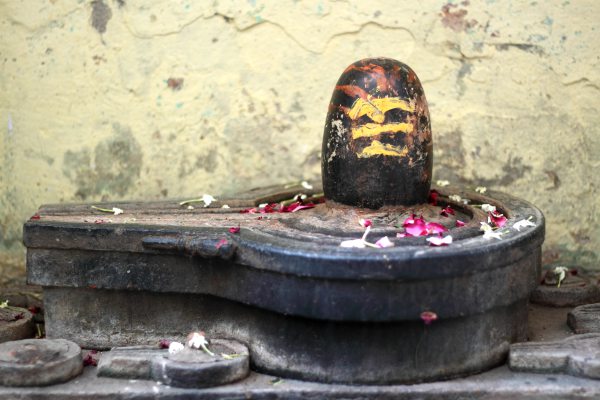
The Lord of the 5th collect of the Mass is neither the Lord of the first collect (the Sun) nor the Lord of the second collect (the Lord secret and most holy).
He can’t be the secret and most holy Lord, because he is manifested. He is “the might of man” and is adored in places in nature, in temples and houses, and in our bodies.
He can’t be the Sun, either, because while the Sun is manifested (visible and sensible), the Sun is “our Lord in the Universe,” i.e., the god of the macrocosm or the demiurge. The Lord of the fifth collect, by contrast, is clearly associated with “the surface of the Earth” or the microcosm.
So what god or principle is manifested like the Sun but instead of being in the heavens is on the surface of the Earth?
“I believe … in one Father of Life, Mystery of Mystery, in His name CHAOS, the sole viceregent of the Sun upon the Earth…”
The Lord of the fifth collect must be CHAOS, the viceregent or representative of the rulership of the Sun upon the Earth.
The Sun is “represented” on Earth as light, as electromagnetic radiation. It is the energy of the Sun that allows plants to make food. It’s the energy that drives the weather and the transportation of water and many other natural processes necessary to life. Because of the light of the sun, the death of the individual is not the death of life itself. Life is renewed, and therefore death is no cause for sorrow. Hence the Sun is “light [and] life,” and the Lord of the 5th collect, Chaos, is “lord of Life and Joy”.
So then who are the saints? They are described as those who “adore” or who make “manifest [the] glory” of the Lord of the 5th collect. They are men who one way or another acknowledged the divinity of manifest, microcosmic existence, right here on Earth.
The saints are of the “true church of old time,” and their knowledge is passed down “generation unto generation.” In other words, their form of worship is not one which is necessarily taught any more than their churches are standing buildings. It’s more like a phylogenic memory of nature worship that’s passed down through the blood—or at the very least is self-evident to any with eyes to see or ears to hear. Christianity has buried this memory under heaps of superstition, but it can be reactivated whenever we engage external nature spontaneously and joyously through singing, dancing, and making love in a religious context.
“Religion must represent Truth, and celebrate it. This truth is of two orders: one, concerning Nature external to Man; two, concerning Nature internal to Man. Existing religions, especially Christianity, are based on primitive ignorance of the facts, particularly of external Nature. Celebrations must conform to the custom and nature of the people. Christianity has destroyed the joyful celebrations, characterized by music, dancing, feasting, and making love; and has kept only the melancholy.”
(Equinox III:1)
“Human nature demands (in the case of most people) the satisfaction of the religious instinct, and, to very many, this may best be done by ceremonial means. I wished therefore to construct a ritual [The Mass] through which people might enter into ecstasy as they have always done under the influence of appropriate ritual … I resolved that my Ritual should celebrate the sublimity of the operation of universal forces without introducing disputable metaphysical theories. I would neither make nor imply any statement about nature which would not be endorsed by the most materialistic man of science. On the surface this may sound difficult; but in practice I found it perfectly simple to combine the most rigidly rational conceptions of phenomena with the most exalted and enthusiastic celebration of their sublimity”
Aleister Crowley, Confessions
Such worship will awaken the innate, “essentially present” memory of the original worship. The “light” of the Sun will “crystallize in our blood”. It will come out of its dissolved, latent state and become an explicit awareness of the divinity of everything we see around us. We will come to a correct understanding of resurrection and no longer fear death. With its dramatization of the reproductive process and its celebration of all aspects of nature and life through the collects, Liber XV is such a ritual.
So the idea that the Lord of the 5th collect is CHAOS not only helps make sense of exactly who the saints are and why their church is the “true church”; it also explains exactly how the Mass fulfilled Crowley’s intention of creating a public religious ceremony that allowed people to enter into ecstasy—thus compensating for Christianity’s error—while also remaining on a purely naturalistic footing.
Toward Erotic Liberation in the Mass
Thelema can be looked at as a path of return to nature (Nuit, Babalon, or Isis), from out of death (Osiris), by means of the spirit of erotic destruction (Apophis or the HGA). It’s the IAO formula in reverse.
The spirit of erotic destruction takes the form of Baphomet in Liber XV. Baphomet is the Lion-Serpent (HGA) that destroys the destroyer (death or limitation) by means of love. Paradoxically we invoke annihilation upon ourselves so we may live for the first time.
This mystery is presented as a cultic rite in Liber XV.
The Gnostic Mass as a Religious Rite
When interpreting the Mass, it’s important to keep in mind that it’s a religious rite, and so it’s not possible to capture the main idea behind it simply with categories that apply to magic(k), mysticism, or the mysteries of OTO.
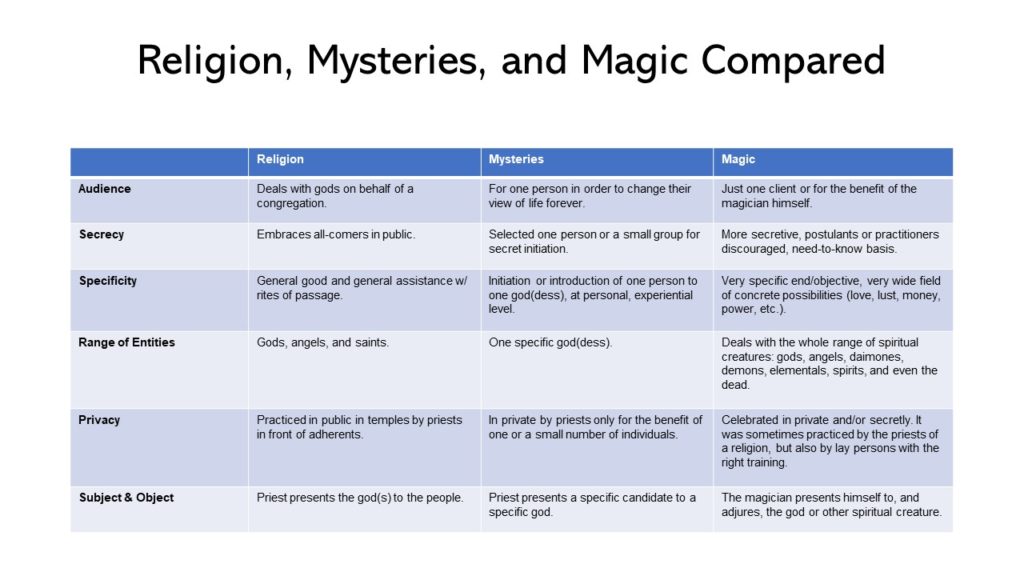
This is a slide from my Minerval lecture summarizing Stephen Skinner’s treatment of these categories in Introduction to Techniques of Graeco-Egyptian Magic. I use this to show what is distinctive about initiation into a mystery school (such as M∴M∴M∴) versus attending Mass or doing private ritual at home. But it’s also useful for seeing what is distinctive about the Mass as a religious rite.
One of the main objectives of the Mass is implied by the Priest right at the start of the ritual: it’s to administer the virtues to the breathren. I think the simplest, most direct interpretation of that statement is that the ritual imparts the spirit of Thelema or the New Aeon to the public, both through its liturgy and through the eucharist itself.
To put a finer point on it, I disagree with an interpretation of the Mass according to which the Priest is exemplifying communing with his Holy Guardian Angel or Crossing the Abyss. That would be a mystical or magical interpretation. I think that renders the actions of the clergy excessively personal and private and tends to obscure the public cultic dimension. I think it also leads to the conclusion that the Priest is feeding his Holy Guardian Angel to the congregants (eww).
I have a long, detailed argument about what exactly is embodied in the eucharist. The short, simple answer is that it embodies the spirit that gave rise to the Book of the Law. So in yet another sense, the Book of the Law becomes your sustenance and comfort when you consume the bread and wine.
Now the spirit that gave rise to the Book of the Law is also the Holy Guardian Angel. (Crowley calls it Aleph, Harpocrates, and a bunch of other names.) So it’s easy to see why one would think that the Mass involves the Priest communing with his HGA. It’s actually not a stupid interpretation. And I could even accept an interpretation which said that the Priest communed with his HGA somewhere along the way in the ritual—or even that the congregants are there to do something similar. It’s not going to detract from it.
I just don’t think it’s the main objective of the ritual. It’s clear from the liturgy, from the presence of a congregation, from the ritualists taking up ecclesiastical roles, and just from things that Crowley said about the ritual when he was alive that the ritual is not meant to be simply mystical or magical, it’s meant to impart a particular kind of spirit (for lack of a better word) to the public. It’s meant to serve and help structure the self-understanding of a community.
Solar-phallicism and EGC gender policy
When I was talking yesterday about the importance of understanding Thelemic theology, I did not mention the specific theological doctrines I thought were important. When I wrote my response to Polyphilus’s Agape article, I underlined the importance of understanding 0=2 and Kabbalah. Those are important theological doctrines for understanding Crowley’s spirituality, but those are not the most important doctrines for understanding the Gnostic Mass. In my opinion the most important doctrine for understanding the Gnostic Mass—at least as far as the issues of sex and gender go—is solar-phallicism.
Two really good books I’ve read on solar-phallicism are The Theosophical Enlightenment by Joscelyn Godwin and a book I’m reading right now called The Aryan Christ by Richard Noll. The second book is actually about Carl Jung, but the doctrine Jung held to is close to Crowley’s. This isn’t because “Jung was a Thelemite,” as several people have mistakenly claimed to me. It’s because solar-phallicism was a major spiritual fad in the late-19th and early-20th centuries. There were just a lot of people—especially countercultural figures—who believed in solar-phallicism and saw it as a doctrine of liberation from the strictures of Christianity.
Solar-phallicism is basically the idea that the original religion was a form of sun-worship. Giordano Bruno had claimed that the Corpus Hermeticum represented the teachings of an original magical Egyptian sun religion that predated Judaism. Sir William Drummond extended and developed this argument in the 18th century, arguing that Jesus was just the Sun in the zodiac of 12 apostles. There was a late-19th century version of this idea, which heavily influenced Carl Jung, which said that the original Aryan religion was a form of sun-worship, and the Aryan people actually carried a phylogenic memory of this in their blood. According to this theory, the Jews had been “civilized” for longer than the Aryans and no longer carried this memory.
Biological reductionism was integral to this theory, with different races or “types” carrying different spiritual memories in their “blood” or other bodily fluids. The Sun was not just an astronomical or “macrocosmic” body. There was also an “interior” Sun or a “midnight Sun” or a “microcosmic Sun” which we carry within ourselves in the form of a drive to procreate.
Richard Payne Knight was the most famous “phallicist” of the 18th century. He claimed all religion was at its root worship of the “generative power”. Following Freud’s terminology, Jung simply referred to this as “libido” and claimed all true spirituality was to be found in it. What he eventually cleaned up, urbanized, and called “individuation” was originally a process of inward journey in which the buried sexual impulses are released from the constraints of Christian morality through an abandonment to sexual, pagan, biological forces within, leading one to deification. Jung recommended to all of his male patients that they engage in polygamy. He believed spiritual growth was impossible without releasing the libido from the constraints of Christian sexual morality.
Awhile back, an EGC bishop defended clergy gender requirements by claiming that the gender identities of the ritualists serve as symbols of macrocosmic and microcosmic polarities. I believe what he had in mind was either identical with or very close to the doctrine I just outlined. By macrocosmic polarity, he in all likelihood meant the Supernal Father and the Supernal Mother whose unity gives rise to the Sun. By microcosmic polarity, I think he intended the joining of phallus and kteis which gives rise to the Child.
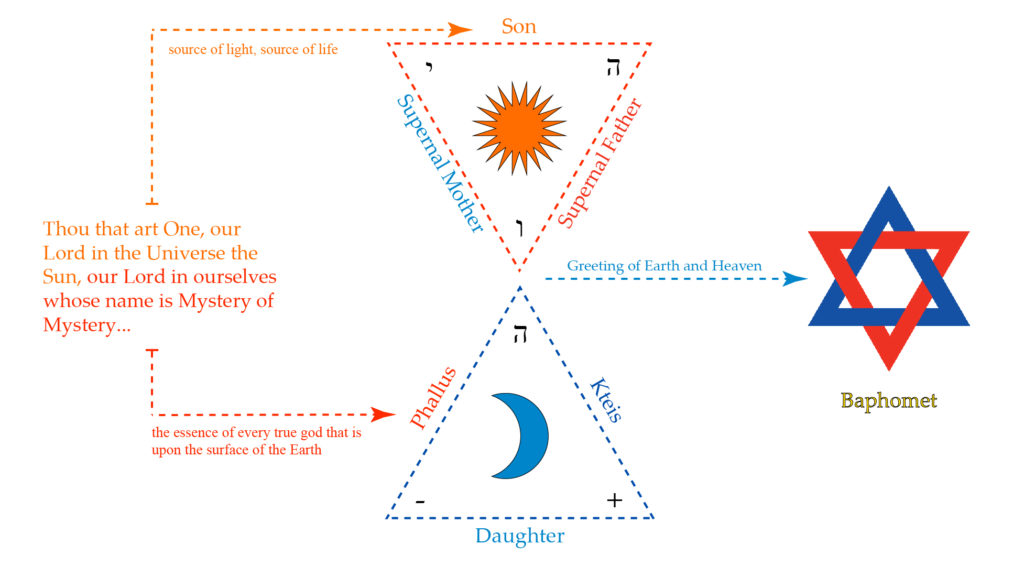
Interestingly, this same bishop gives a talk on sex magick in which he claims that women have phalluses. He does not think the phallus is the male sexual organ, in other words. I’ve heard other Thelemites make a similar claim. They talk about the phallus, not as the male sexual organ, but rather as a kind of masculine magical energy that both men and women have.
Jung may have held to a version of solar-phallicism that is similar to that. For instance while he thought the libido was biological in nature, he did not think it was the sex instinct pure and simple. However, I do not believe Crowley himself held to that more generalized view. I think that by “phallus” Crowley absolutely meant cock.
Part of the problem with trying to “liberalize” Crowley by abstracting his thought away from particular biological doctrines he held to is that he was so specific. When he says, “Semen is God,” he is not leaving anything up to the imagination. He’s quite explicit about biology—especially sexual biology—and how for him it determines spirituality. Liber Aleph is full of such elaborations on sexually-determined spiritual differences.
I’ve heard the argument before that women, too, have sexual fluids. For example, perhaps what Crowley says about male ejaculate could be extended to female ejaculate.
Again, Crowley is too specific for that interpretation. In case you were in any doubt about what he meant, he identifies the spermatazoon IN PARTICULAR, not just the fluid medium it is transported in, as being magically significant. It is the “Lion-Serpent” or the “Yod” which is so important in the VIAOV formula, which so accurately describes the magick of the mass’s eucharist.
This is also the problem with saying, “But in tantra, there are many fluids that are magical, not just male sexual fluid.” Yes, but OTO solar-phallicism is not tantra. That’s not what Crowley himself believed, it has a completely different historical origin, and it’s not relevant to Thelema or the Mass.
This is ultimately why I do not think you should critique current EGC policy regarding gender and clergy from the perspective of Crowley’s spiritual doctrine, at least not if you want to liberalize it in the direction of allowing gender fluidity. The spirituality informing OTO and the Mass in particular is reductionistic in a way which is gender-essentialist to the extreme. To the best of my understanding of OTO spirituality, the current policy is already way, way more liberal than I think Crowley himself would have allowed for just on the basis of the sexual magick doctrines themselves.
Effertz argues in Priest-ess that IX° sex magick can be homosexual and XI° sex magick can be heterosexual, so if the mass is based on those sex magical formulae, that allows for queer mass. The only problem with this argument is that in every queer example of IX° and XI° magick we have from Crowley’s diaries, there was still always cum involved. That implies that cum is the determing factor. I brought this up to Effertz, and he agreed. Cum is a limiting factor. As far as I can tell, the reason it’s a limiting factor is because cum itself is God in Crowley’s view.
Ironically, I think the current policy—as well as the justification that bishop attempted to give—represents a well-intentioned attempt to accommodate transgender people. If there appear to be reprehensible beliefs preventing that policy from becoming even more accommodating, I believe those reprehensible beliefs do not stem solely from those currently setting EGC policy. The ugly parts actually come from the solar-phallicist theology informing OTO spirituality.
I’ve heard the claim made many times now that “Crowley was a product of his time” or “Crowley was radical for his time, but now we have to update that idea for the 21st century.”
This is not a great argument for one very simple reason. Solar-phallicism was not a stage or a step on a path from patriarchy to the present day. It was more like a weird tangent in European spirituality based on a fantasy of the past and fantasies about biology. It was part of a branch of thought which terminated, not in the present day, but in the Nazi death camps. It’s not to say that Crowleyism is Nazism, only that that set of ideas was a fad that went out of style a long time ago, and for good reasons. In other words, I don’t think there is an “updating” of that doctrine.
But here’s the other side of it. OTO is already not run the way Crowley himself intended. From the very beginning of its reestablishment, we have departed from the Blue Equinox model in probably a hundred ways. This is why I continue to say—as Effertz effectively argued in Priest-ess—that some of the best arguments we have for queer mass are already embodied in current EGC policy and in clarifications of the spirituality put forward by Sabazius.
They’re not going to roll that policy back. They’re not going to disallow transgender clergy to do mass. They’re not going to start requiring that women and men both have to be fertile to do mass. They’re not going to start demanding that men and women have to be conventionally attractive to do mass—which is a requirement Crowley himself definitely, verifiably wanted in place.
I would just keep drawing attention to the contradiction. There are a hundred different ways that what we’re doing now deviates from Crowley’s original vision. Why are we going to draw a line in the sand over this one particular thing, especially when it is so out of step with all our intuitions about fairness? As long as you continue to occupy a self-contradictory position based on arbitrary views about gender, you’re going to incite critique. You can’t go backward, so the only way to go is forward. IMHO that’s the way to argue for it.
But if you want to understand why the current policy is the way it is, it’s clearly because of solar-phallicism and the biological reductionist views Crowley picked up from Nietzsche and Reuss and Richard Payne Knight and other figures. That’s why Crowley thought it was cum all the way down. I think church officials are trying to maintain some link with that doctrine, even if it’s just symbolic, while also trying to acknowledge that the world has moved on. At least that’s the most generous reconstruction I can offer for what they’re trying to do.
